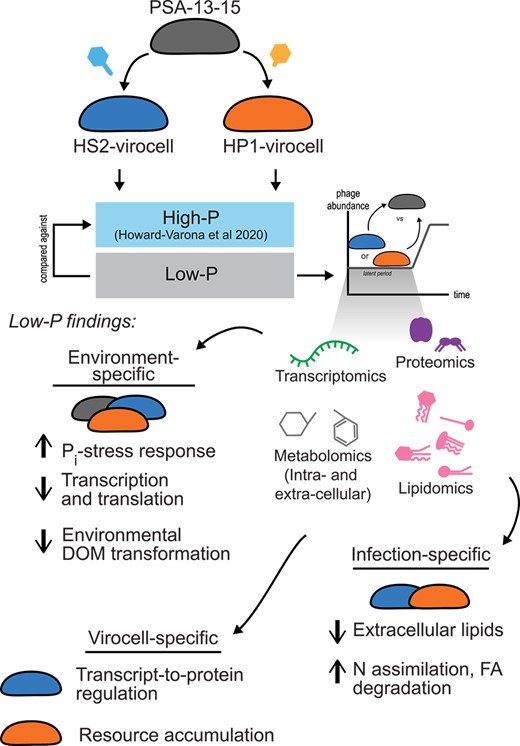2024-08-02 パシフィック・ノースウェスト国立研究所(PNNL)
◆研究者たちは、海洋細菌Pseudoalteromonasを2種類のウイルスで感染させ、異なるリン酸塩レベル下での代謝変化を調査しました。結果、栄養が制限されるとバイロセルは複製を優先することが判明しました。この研究は、栄養が限られた自然環境下でのバイロセルの代謝戦略を特定するためのフレームワークを提供します。
<関連情報>
- https://www.pnnl.gov/publications/marine-bacteria-reprograms-its-metabolism-after-viral-infection-amid-nutrient
- https://academic.oup.com/ismej/article/18/1/wrae055/7637540
環境特異的なウイルス細胞の代謝リプログラミング Environment-specific virocell metabolic reprogramming
Cristina Howard-Varona, Morgan M Lindback, Jane D Fudyma, Azriel Krongauz, Natalie E Solonenko, Ahmed A Zayed, William B Andreopoulos, Heather M Olson, Young-Mo Kim, Jennifer E Kyle …
The ISME Journal Published:29 March 2024
DOI:https://doi.org/10.1093/ismejo/wrae055

Graphical Abstract
Abstract
Viruses impact microbial systems through killing hosts, horizontal gene transfer, and altering cellular metabolism, consequently impacting nutrient cycles. A virus-infected cell, a “virocell,” is distinct from its uninfected sister cell as the virus commandeers cellular machinery to produce viruses rather than replicate cells. Problematically, virocell responses to the nutrient-limited conditions that abound in nature are poorly understood. Here we used a systems biology approach to investigate virocell metabolic reprogramming under nutrient limitation. Using transcriptomics, proteomics, lipidomics, and endo- and exo-metabolomics, we assessed how low phosphate (low-P) conditions impacted virocells of a marine Pseudoalteromonas host when independently infected by two unrelated phages (HP1 and HS2). With the combined stresses of infection and nutrient limitation, a set of nested responses were observed. First, low-P imposed common cellular responses on all cells (virocells and uninfected cells), including activating the canonical P-stress response, and decreasing transcription, translation, and extracellular organic matter consumption. Second, low-P imposed infection-specific responses (for both virocells), including enhancing nitrogen assimilation and fatty acid degradation, and decreasing extracellular lipid relative abundance. Third, low-P suggested virocell-specific strategies. Specifically, HS2-virocells regulated gene expression by increasing transcription and ribosomal protein production, whereas HP1-virocells accumulated host proteins, decreased extracellular peptide relative abundance, and invested in broader energy and resource acquisition. These results suggest that although environmental conditions shape metabolism in common ways regardless of infection, virocell-specific strategies exist to support viral replication during nutrient limitation, and a framework now exists for identifying metabolic strategies of nutrient-limited virocells in nature.


